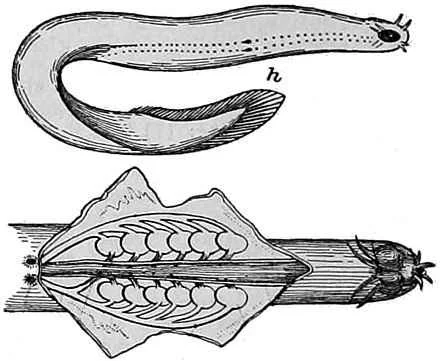Bdellostoma (Hag Fish)
In Bdellostoma, each pouch opens separately to the outside, as in lampreys.
 |
| Bdellostoma Hag Fish |
Geographical distribution of Bdellostoma
Bdellostoma is distributed in the Pacific coasts of North and South America, South Africa and New Zealand.
Habit and habitat of Bdellostoma
Bdellostoma is found buried in mud and sand during the day; otherwise, it is a nocturnal feeder and ectoparasitic and is highly adapted for sucking.
Comments on Bdellostoma Hag Fish
(1) Bdellostoma is commonly called hag fish.
(2) Body is elongated, soft, eel-like without scales, and divided into head, trunk, and tail.
(3) Teeth well developed. Jaws are completely absent.
(4) Eyes rudimentary, skin sensory. Eight sensory tentacles are found around mouth. Single nostril close to the mouth.
(5) Gills modified into 6 to 14 pouches opening independently.
(6) Entire body contains double rows of mucous glands and opening by double row of mucous pores.
(7) Blood is isosomatic with sea water. The dorsal fin is continuous with the caudal fin.
(8) Egg is yolky with partial cleavage leading to the formation of an embryo perched on a mass of yolk.
(9) Single pineal eye is present at the top of head.
(10) Hag fish is hermaphroditic and protandrous.
Special features
It has the same phylogenetic importance as that of Myxine Pronephros persistent in adults but the functional kidney is mesonephros. Identification: Since the animal is without jaws and with 8 tentacles and above features, hence it is Bdellostoma.
Reproduction in Bdellostoma Hag Fish
Very little is thought regarding jawless vertebrate copy (reproduction). getting embryos and observant fruitful behavior square measure troublesome because of the sea environs of the many jawless vertebrate species. within the wild female's number males, with the precise sex-ratio differing reckoning on the species. E. burger, for instance, has nearly a 1:1 quantitative relation, while M. glutinosa females square measure considerably a lot of common than males. Some species of jawless vertebrates square measure sexually undifferentiated before maturation and possess ductless gland tissue for each ovary and ball. it's been urged that females develop before males, which might be the rationale for unequal sex ratios. jawless vertebrate ball square measure comparatively tiny.
Depending on the species, females lay from one to thirty robust, yolky eggs. These tend to be a mixture because of having Velcro-like tufts at either finish. it's unclear however jawless vertebrates move birth eggs, though researchers have planned 3 hypotheses supported by observations of the low proportion of males and little balls. The hypotheses square measure that feminine jawless vertebrates lay eggs in tiny crevices in rock formations, the eggs square measure ordered in a burrow below the sand, and therefore the slime created by the jawless vertebrate is employed to carry the eggs in a very tiny space. it's price noting that no evidence has been found to support any of those hypotheses. jawless vertebrates don't have a larval stage, in distinction to lampreys.
FAQs on Bdellostoma Hag Fish
1. What is Bdellostoma commonly known as?
Answer: Bdellostoma commonly known as Hag fish.
2. How is the body of Bdellostoma described?
Answer: Elongated, soft, eel-like without scales, divided into 3 parts- head, trunk, and tail.
3. Are jaws present in Bdellostoma?
Answer: No, jaws are completely absent in Bdellostoma.
4. What are the sensory organs of Bdellostoma?
Answer: Eyes are rudimentary, and the skin is sensory. It has eight sensory tentacles around the mouth and a single nostril close to the mouth.
5. How are the gills of Bdellostoma modified?
Answer: The gills of Bdellostoma are modified into 6 to 14 pouches that open independently.
6. What is the special characteristic of mucous glands in Bdellostoma?
Answer: The entire body of Bdellostoma contains double rows of mucous glands and opening by a double row of mucous pores.
7. What is the composition of blood in Bdellostoma?
Answer: The blood of Bdellostoma is isosomatic with seawater. The dorsal fin is continuous with the caudal fin.
8. How is the egg of Bdellostoma described?
Answer: The egg of Bdellostoma is yolky with partial cleavage, leading to the formation of an embryo perched on a mass of yolk.
9. What unique sensory organ is present in Bdellostoma?
Answer: A single pineal eye is present at the top of the head.
10. Is Bdellostoma hermaphroditic?
Answer: Yes, Bdellostoma is hermaphroditic and protandrous.

No comments:
Post a Comment